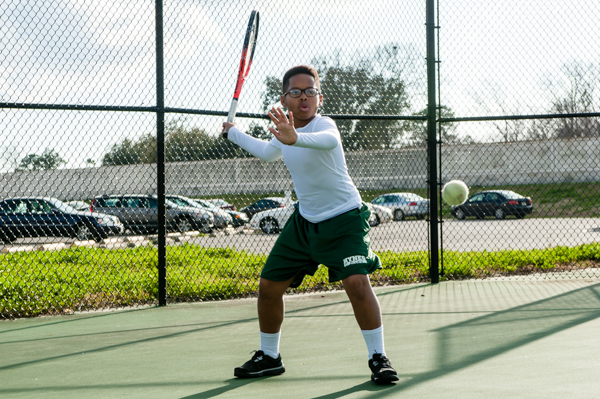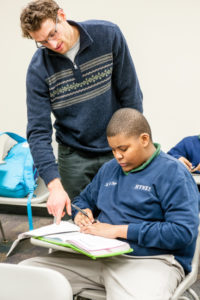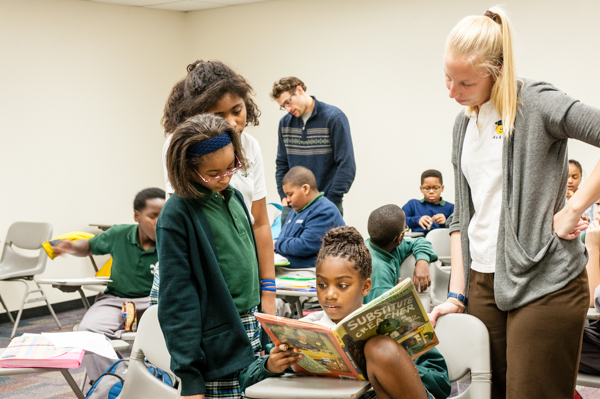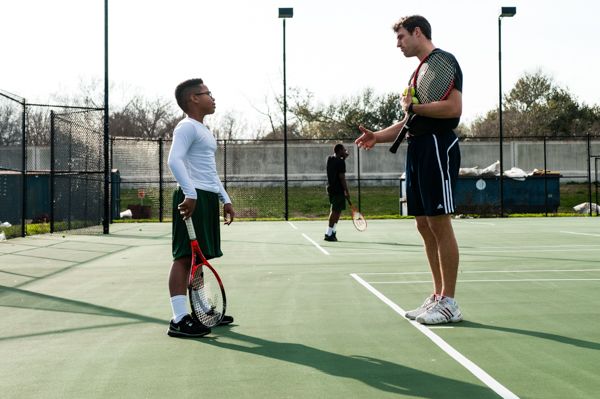A’s and Aces teaches game of tennis, life

A bean bag flies across a classroom filled with elementary school students. The thrower’s teamwork is encouraged, the catcher’s sportsmanship commended, all students in the circle soaking up the life skills lessons they aren’t even fully aware they are learning.
The kids are part of the A’s and Aces after-school program, a curriculum that uses the game of tennis to teach life skills and character development to New Orleans public school children.
“Tennis is the hook,” explains co-founder David Schumacher. “We get them in through tennis because tennis is fun, but this is A’s and Aces; we’re working to promote literacy.”
Students spend half of their time in the classroom, the other half on the tennis court with the coaches. In the classroom, kids learn the rules of tennis and scorekeeping as well as the overall discipline of being an athlete, including proper nutrition. Younger kids begin with tossing foam balls and bean bags, easier for little hands to catch; on rainy days, this indoor substitute allows the program to keep the tennis-playing alive. Outside on the courts, 6 kids are assigned to each coach where they put their classroom knowledge into practice and practice applying the life skills in a competitive, athletic environment.
“We play tennis and we have a lot of fun,” says 3rd grader Isaiah Porea. “We also do activities and arts and stuff, we get to make 3-D sculptures with paper and we play tennis games like ‘King of the Court’ and ‘Skeletons.’ The best part about it is sometimes you win, and Coach makes you not pick up the balls!”
According to Schumacher and co-founder Anna Manhartova, the non-profit program has

10 full and part-time staff members and coaches, and more than 100 volunteers to serve 150 kids, 100 percent of whom are on the free or reduced lunch program and 70 percent of whom live in single-parent homes.
“Our kids have a better ratio on the court with our volunteers than they do at home with their families,” Schumacher says.
Founded in 2008 by Schumacher and Monhartova as a way to give back to the community, A’s and Aces benefits from a partnership with Tulane, where Monhartova and Schumacher met. Recruited by then-Coach Schumacher, Monhartova left her native Czech national team and came to New Orleans and became a top-10 nationally ranked college tennis player and was inducted to Tulane University Athletics Hall of Fame in 2007. Monhartova earned a PhD at Tulane, where she now teaches classes; her students generate classroom volunteers who serve as tutors and mentors to the A’s and Aces kids.
“The underlying principle for it all is reading and writing,” Monhartova says. “Academics and tennis are our focus. Instead of handing a child a book and telling them to read it, we use engaging topics to get them writing. They are engaging in literacy without even knowing it.”
Dillard University and Gentilly Terrace Charter School host the after school programs for A’s and Aces. There’s also a Saturday program and summer camp programs in partnership with the New Orleans Recreation Department Commission (NORDC) and Southern University at New Orleans (SUNO).
Freya Hoffman-Terry, one of the classroom instructors for A’s and Aces, was drawn to the program because it aims to make learning fun.
“I feel like the movement toward testing and data-driven education is useful to a point,” Hoffman-Terry says, “but at the same time, kids have to be engaged and having fun to get the most out of school — particularly the ones who have learning disabilities, so they can feel they are good at something, even if it’s not reading or writing.”
Hoffman-Terry is a former Peace Corps volunteer and competitive athlete whose previous work in the Boston public school system was of a similar mission, combining athletics with creative writing and community service.
“I grew up loving sports and finding a lot of self-confidence through sports,” Hoffman-Terry says. “I really want to encourage that and give students those opportunities, especially kids in New Orleans who may not have those sports opportunities.”
Bean Bag Time is a classroom activity where students share about their daily lives. Hoffman-Terry asks a question, tosses the bean bag, and as each student catches the bean bag, takes a turn contributing their answer. One day, Hoffman-Terry recalls, she asked the students to describe the highlight of their past week, and one little guy who caught the bean bag answered, “I got to visit my Dad in jail.”
“They say things that are very outside my scope of experience and it reminds me how hard life can be for such young kids,” Hoffman-Terry says, a realization that fuels her desire to work with A’s and Aces. Such moments provide opportunities for the kids to respond to their peers, using the life lessons that they learn through the curriculum.
“We have lots of teachable moments where someone is not being supportive or blaming someone,” Hoffman-Terry says. “I’ve seen some students, particularly some of my tough little boys, really make some powerful progress. There’s something very special for me when I see little boys who come with all this toughness and negativity, and then see them understand things bigger than toughness or anger. When I see them have these moments of turning around, really engaged or working together as part of a team, it’s something that helps fuel me.”
Tennis coach Eric Pallin says the consistent enthusiasm from the kids makes the work particularly rewarding.
“They’re never down about anything for more than several minutes,” Pallin says. “They rebound very quickly.”
Hoffman-Terry says the children are full of energy and excitement and it’s incredibly challenging to keep them sitting still even for short amounts of time. As a result, her academic lesson plans are fairly active and often end with a bean bag challenge, a surprisingly challenging activity involving tossing, catching, and clapping that encourages the hand-eye coordination players need on the tennis court.
“One of the really nice things about A’s and Aces is that it has allowed me to work with very small groups of students, six to eight at a time,” Hoffman-Terry says. “That may be the only time they get to read a story in a small enough group that they get to see the picture or have that opportunity to share in front of the class.”




Published in The New Orleans Advocate, May 15, 2014.